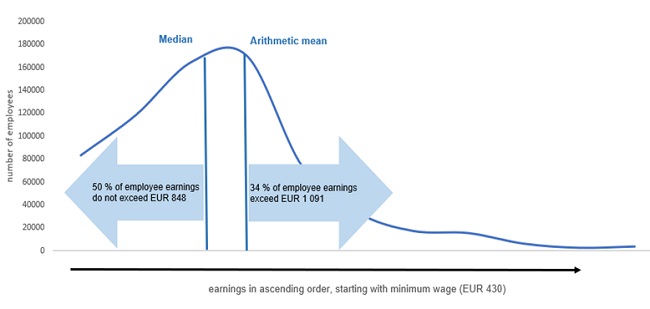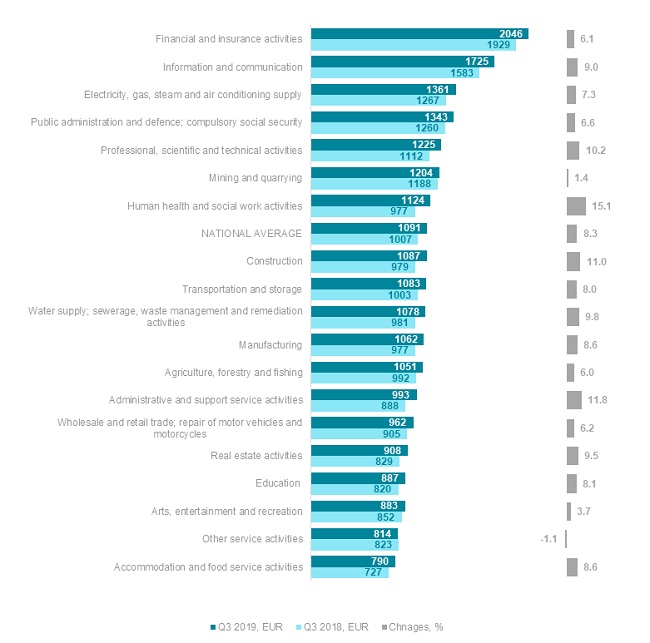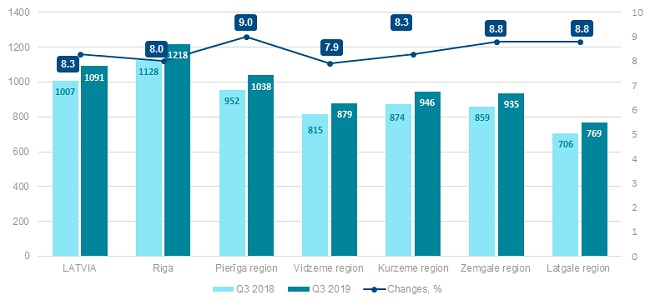Analytics, Latvia, Statistics, Wages
International Internet Magazine. Baltic States news & analytics
Friday, 19.04.2024, 19:52
Latvia: 1 091 euros received for the full-time work in the 3rd quarter
 Print version
Print versionCompared to the 2nd quarter of 2019, in the 3rd quarter of 2019 gross wages and salaries grew by 0.7%.
Net earnings amounted to EUR 801
In the 3rd quarter of 2019, the average net wages and salaries (calculated based on the labour taxes applicable at workplace) constituted EUR 801. Over the year, net earnings rose by 7.7%, while compared to the 2nd quarter of 2019 they rose by 0.3%.
Considering annual consumer price growth of 2.9%, the real increase in net wages and salaries comprised 4.7%.
Median wages and salaries amounted to EUR 848
In the 3rd quarter, median gross wages and salaries constituted EUR 848, and compared to the 3rd quarter of 2018 (EUR 779) they grew faster than mean arithmetic earnings (rise of 8.8%). Over the quarter, net median earnings (after taxes) comprised EUR 623 and rose by 8.3% over the year.
Median is calculated based on the information available in statistical surveys and administrative data of the State Revenue Service.
Median is an average indicator located in the middle of employee earnings sorted in an ascending or descending order. As median, compared to the mean arithmetic earnings, is not influenced by extremely high or low wages and salaries, it reflects typical earnings more precisely.

Similar growth in both private and public sector
In the 3rd quarter of 2019, average monthly gross wages and salaries in public sector exceeded the indicator recorded in private sector by EUR 45 (EUR 1 124 and EUR 1 078, respectively), however annual increase rate was similar in both sectors – 8.5% and 8.4%, respectively. Average wages and salaries in general government sector, which includes central and local government institutions, as well as enterprises controlled and financed by the central and local government, grew to EUR 1 081 or by 8.9%.
(euros)
|
|
Q3 2018 |
Q1
2019 |
Q2 2019 |
Q3 2019 |
Changes
in Q3 2019, as % compared to: |
|
|
Q3 2018 |
Q2 2019 |
|||||
|
Total |
1007 |
1036 |
1083 |
1091 |
8.3 |
0.7 |
|
private sector |
994 |
1038 |
1079 |
1078 |
8.4 |
-0.1 |
|
public sector |
1036 |
1035 |
1097 |
1124 |
8.5 |
2.4 |
|
general government sector |
993 |
985 |
1040 |
1081 |
8.9 |
3.9 |
* Data on 2019 are provisional.
Changes in the average wages and salaries are influenced not only by the rise of employee remuneration, but also structural changes on the labour market – enterprises that had started and stopped their business during the year, changes in the number of employees and workloads in various economic sectors, as well as state administrative measures in the fight against the shadow economy. The effects caused by the mentioned factors in general may be seen in the changes in the wage and salary fund and number of full-time employees, which are used in the average wage calculations.
Compared to the 3rd quarter of 2018, in the 3rd quarter of 2019 gross wage and salary fund increased by 8.9% or EUR 204.9 mln, while the number of salaried workers, recalculated into full-time units, grew by 0.5% or 3.9 thousand.
In the 3rd quarter of the year, the sharpest rise in wages and salaries was recorded in human health and social work activities (of 15.1%), which was mainly influenced by the increase of earnings in health care. Over the year, the average wages and salaries grew over 10 % also in administrative and support service activities (11.8%, with sharper rise in rental and leasing activities; travel agency, tour operator reservation service and related activities), construction (11.0%), as well as professional, scientific and technical activities (10.2%, with a faster upturn legal and accounting activities (where average changes in earnings were mainly influenced by reduction in the number of employees and not the rise in wage and salary fund) and architectural and engineering activities).
During the year, wage and salary reduction was observed in other service activities (that includes activities of public and other organisations, repair of computers and personal and household goods, washing and (dry-)cleaning, hairdressing and other beauty treatment, funeral and related activities) – of 1.1%.
Average earnings above EUR 1 000 in twelve economic activities
In the 3rd quarter of 2019, average wages and salaries for full-time work exceeded EUR 1 000 in 12 economic activities out of 19. In seven – financial and insurance activities, information and communication, energy sector, public administration, professional, scientific and technical activities, mining and quarrying, as well as human health and social work activities – average earnings exceeded the national average.
Average monthly gross wages and salaries in Q3 2018 and Q3 2019 and changes thereof by economic activity

The lowest average wages and salaries, in turn, were registered in accommodation and food service activities, other service activities, arts, entertainment and recreation, as well as education.
Steeper rise in earnings observed in Pierīga
Compared to the 3rd quarter of 2018, in the 3rd quarter of 2019 regional breakdown shows the sharpest rise in the average monthly gross wages and salaries in Pierīga region (of 9.0%), followed by Zemgale and Latgale (8.8%). The smallest rise was recorded in Vidzeme region (7.9%). The lowest earnings were registered in Latgale region – EUR 769 for full-time work, constituting 71% of the national average and 63% of the average gross wages and salaries in Riga (EUR 1 218).

Highest earnings in Estonia, while highest rise in Lithuania
In the 3rd quarter of 2019, the highest gross earnings among the Baltic states were registered in Estonia (EUR 1 397 for full-time work), while the lowest in Latvia (EUR 1 091). In Lithuania, where the social security contribution rates payable by employers and employees were changed as of 1 January 2019 and gross earnings were indexed 1.289 times, average gross earnings amounted to EUR 1 318.
Compared to the 3rd quarter of the previous year, average wages and salaries have increased in all Baltic states. Excluding the indexing effect, the sharpest rise was recorded in Lithuania (of 9.2%), followed by Latvia (8.3%) and Estonia (8.2%).
This year, the highest minimum wage was recorded in Lithuania (EUR 555), followed by Estonia (EUR 540), and Latvia (EUR 430).








 «The Baltic Course» Is Sold and Stays in Business!
«The Baltic Course» Is Sold and Stays in Business!

